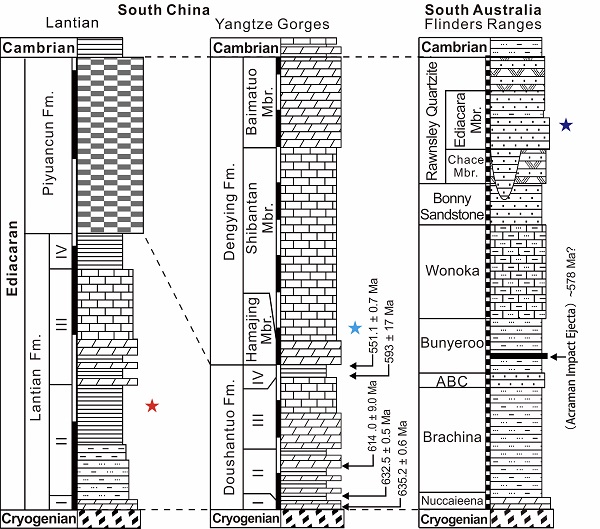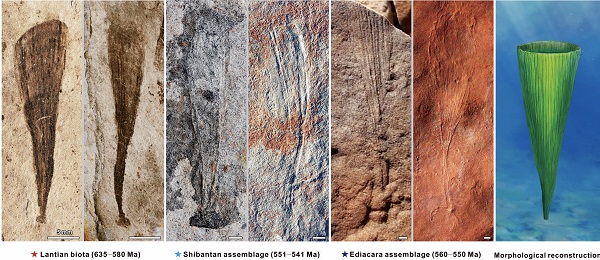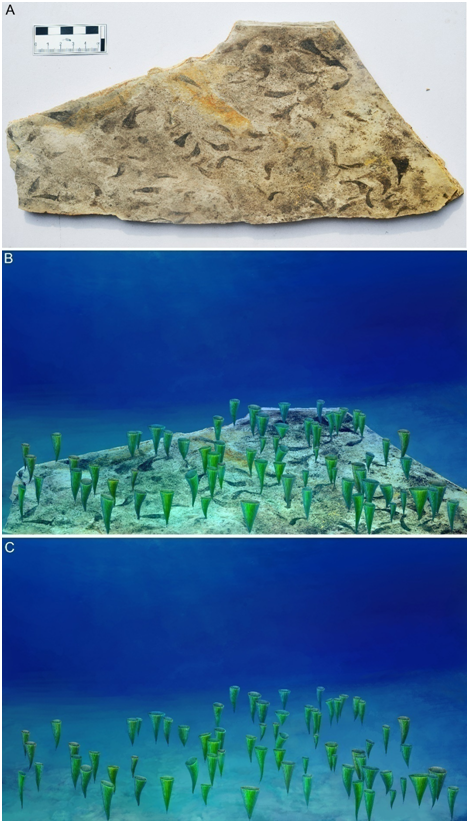The Ediacara biota (580–541 Ma) documents an important evolutionary episode just before the Cambrian explosion and marks the first appearance of macroscopic and complex multi-cellular life. Most Ediacara-type fossils were preserved as casts and molds in sandstone successions, but several recent studies have shown that some taxa of the Ediacara biota can also be preserved as casts and molds in carbonate successions or as carbonaceous. In addition, and some of these taxa also extend to the early Ediacaran Period. Various Ediacaran strata in South China, including black shales in the Doushantuo/Lantian Formation and limestones in the Shibantan Member of the Dengying Formation, are known to preserve Ediacara-type fossils and they offer an opportunity to broaden our view of the stratigraphic, environmental, and taphonomic distributions of the Ediacaran macrofossils.
Recently, Dr. WAN Bin, and other members of the Innovative Research Group on ‘Origin and early evolution of multi-cellular life from Nanjing Institute of Geology and Palaeontology, Chinese Academy of Sciences (NIGPAS), collaborated with researchers from Virginia Tech and University of California at Riverside of USA, and Birbal Sahni Institute of Palaeosciences of India discovered a common Ediacara-type fossil Flabellophyton among the Lantian and Shibantan biotas form South China and Ediacara biota form South Australia. This study was recently published as Focus review on the Gondwana Research,
Flabellophyton was the representative genus of early Ediacaran Lantian biota (635-580 Ma) preserved as carbonaceous compressions in black shales of the Lantian Formation, and later was founded from the Ediacara biota (560-550 Ma) form South Australia preserved as casts and molds in the Ediacara Sandstone. Recently, it was discovered from the Shibantan biota (550-539 Ma), and preserved as casts and molds in the Shibantan Limestone of the Dengying Formation. This discover makes Flabellophytonthe only genus that occurs in all three taphonomic modes.
In this study, they provided a systematic description of Flabellophyton based on material from the Lantian and Dengying formations in South China, recognizing three morphospecies—F. lantianense, F. typicum sp. nov., and F. obesum sp. nov. Based on morphological and structural characters, Flabellophyton is reconstructed as an erect epibenthic marine organism attached to sandy, carbonate, and muddy substrates. Its phylogenetic affinity remains ambiguous though it was historically interpreted as an algal fossil.
Flabellophyton occured in all three taphonomic modes, allowing comparative ecological and taphonomic analyses. First, taphonomic analysis of Flabellophyton indicates that multiple taphonomic pathways can facilitate the preservation of Ediacaran macrofossils. In particular, the precipitation of authigenic minerals such as pyrite, clay minerals, calcite, and possibly silica may have contributed to the preservation of Flabellophyton in a certain degree of three-dimensionality. Second, environmental factors such as water depth, sediment substrates and redox conditions exert a strong control through taphonomic and/or paleoecological processes of Flabellophyton. The wide geographicand environmental distribution of Flabellophyton points to an unusual capability of Flabellophyton to evolutionarily adapt to different environments. Third, as a window into Ediacaran paleoecology, Flabellophyton and other Ediacaran fossils played a crucial role in the construction of epibenthic communities in Ediacaran oceans, and helps to understand the ecologicalmigration and evolutionary expansion from deeper to shallower oceans during the Ediacaran Period.
This research was jointly supported by the the National Natural Science Foundation of China, Strategic Priority Research Program (B) and Major program of the Chinese Academy of Sciences, China and SKLPS State Key Lab Funding of NIGPAS, and National Geographic Society of USA.
Article reference:Bin Wan, Zhe Chen, Xunlai Yuan, Ke Pang, Qing Tang, Chengguo Guan, Xiaopeng Wang, S. K. Pandey, Mary L. Droser and Shuhai Xiao. 2020. A Tale of Three Taphonomic Modes: The Ediacaran Fossil Flabellophyton Preserved in Limestone, Black Shale, and Sandstone. Gondwana Research 84: 296-314. https://doi.org/10.1016/j.gr.2020.04.003


Stratigraphic columns, representative specimens, and morphological reconstruction of Flabelloophyton from the early Ediacaran Lantian biota(635-580 Ma)and late Ediacaran Shibantan biota(551-539 Ma)of South China, and Middle-late Ediacaran Ediacara biota (560-550 Ma) of Australia

Paleoecological reconstruction of Flabellophyton from the early Ediacaran Lantian biota, showing a Flabellophyton community on early Ediacaran ocean floor



